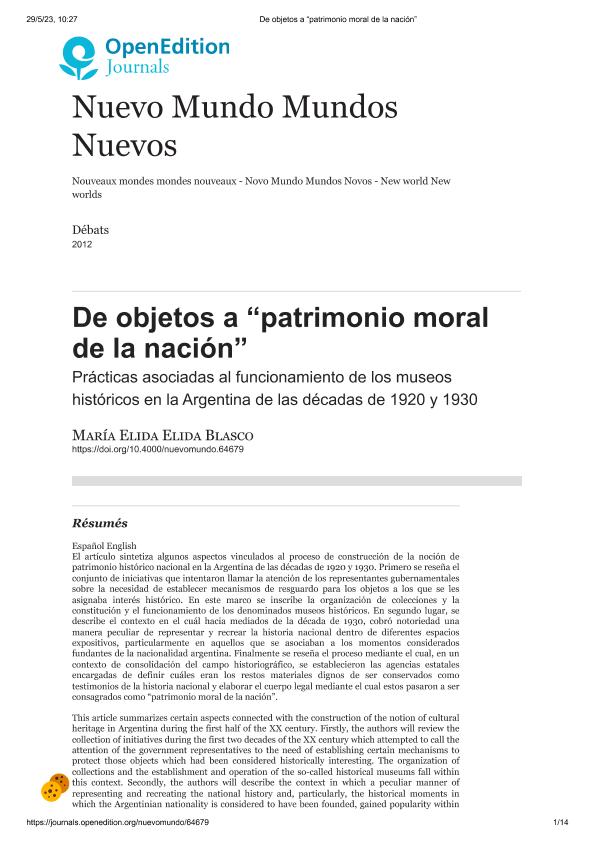Artículo
El artículo sintetiza algunos aspectos vinculados al proceso de construcción de la noción de patrimonio histórico nacional en la Argentina de las décadas de 1920 y 1930. Primero se reseña el conjunto de iniciativas que intentaron llamar la atención de los representantes gubernamentales sobre la necesidad de establecer mecanismos de resguardo para los objetos a los que se les asignaba interés histórico. En este marco se inscribe la organización de colecciones y la constitución y el funcionamiento de los denominados museos históricos. En segundo lugar, se describe el contexto en el cuál hacia mediados de la década de 1930, cobró notoriedad una manera peculiar de representar y recrear la historia nacional dentro de diferentes espacios expositivos, particularmente en aquellos que se asociaban a los momentos considerados fundantes de la nacionalidad argentina. Finalmente se reseña el proceso mediante el cual, en un contexto de consolidación del campo historiográfico, se establecieron las agencias estatales encargadas de definir cuáles eran los restos materiales dignos de ser conservados como testimonios de la historia nacional y elaborar el cuerpo legal mediante el cual estos pasaron a ser consagrados como “patrimonio moral de la nación”. This article summarizes certain aspects connected with the construction of the notion of cultural heritage in Argentina during the first half of the XX century. Firstly, the authors will review the collection of initiatives during the first two decades of the XX century which attempted to call the attention of the government representatives to the need of establishing certain mechanisms to protect those objects which had been considered historically interesting. The organization of collections and the establishment and operation of the so-called historical museums fall within this context. Secondly, the authors will describe the context in which a peculiar manner of representing and recreating the national history and, particularly, the historical moments in which the Argentinian nationality is considered to have been founded, gained popularity within diverse exhibition spaces in the mid 1930s. Finally, the authors will review the process whereby certain government agencies were founded in a context in which the historiographical field was being consolidated. Such organisms were in charge of determining which material remains to preserve as testimonies of the national history and establish the body of law by means of which they would be established as the country’s moral heritage.
De objetos a “patrimonio moral de la nación”: Prácticas asociadas al funcionamiento de los museos históricos en la Argentina de las décadas de 1920 y 1930
Fecha de publicación:
12/2012
Editorial:
École des hautes études en sciences sociales
Revista:
Nuevo Mundo, Mundos Nuevos
ISSN:
1626-0252
Idioma:
Español
Tipo de recurso:
Artículo publicado
Clasificación temática:
Resumen
Palabras clave:
PRÁCTICAS CULTURALES
,
PATRIMONIO HISTÓRICO
,
MUSEOS HISTÓRICOS
,
ESTADO-NACIÓN
Archivos asociados
Licencia
Identificadores
Colecciones
Articulos(CCT - LA PLATA)
Articulos de CTRO.CIENTIFICO TECNOL.CONICET - LA PLATA
Articulos de CTRO.CIENTIFICO TECNOL.CONICET - LA PLATA
Citación
Blasco, Maria Elida; De objetos a “patrimonio moral de la nación”: Prácticas asociadas al funcionamiento de los museos históricos en la Argentina de las décadas de 1920 y 1930; École des hautes études en sciences sociales; Nuevo Mundo, Mundos Nuevos; 12; 12-2012; 1-14
Compartir
Altmétricas




